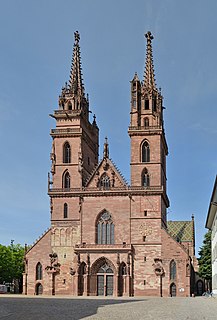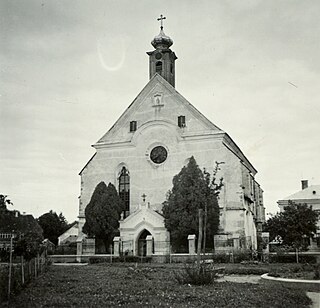An edict of toleration is a declaration, made by a government or ruler, and states that members of a given religion will not be persecuted for engaging in their religious practices and traditions. The edict implies tacit acceptance of the religion rather than its endorsement by the ruling power.

The Berlin Cathedral, also known as, the Evangelical Supreme Parish and Collegiate Church, is a monumental German Evangelical church and dynastic tomb on the Museum Island in central Berlin. Having its origins as a castle chapel for the Berlin Palace, several structures have served to house the church since the 1400s. The present collegiate church was built from 1894 to 1905 by order of German Emperor William II according to plans by Julius Raschdorff in Renaissance and Baroque Revival styles. The listed building is the largest Protestant church in Germany and one of the most important dynastic tombs in Europe. In addition to church services, the cathedral is used for state ceremonies, concerts and other events.

St. Mary's Church, or formally the Basilica of the Assumption of the Blessed Virgin Mary, is a Brick Gothic Catholic church located in central Gdańsk, Poland. With its volume between 185,000 m3 and 190,000 m3 it is currently one of the two or three largest brick churches in the world. Only San Petronio Basilica in Bologna, comprising 258,000 m3 is larger, Munich Frauenkirche and Ulm Minster also comprise 185,000 to 190,000 m3.

The Innere Stadt is the 1st municipal District of Vienna located in the center of the Austrian capital. The Innere Stadt is the old town of Vienna. Until the city boundaries were expanded in 1850, the Innere Stadt was congruent with the city of Vienna. Traditionally it was divided into four quarters, which were designated after important town gates: Stubenviertel (northeast), Kärntner Viertel (southeast), Widmerviertel (southwest), Schottenviertel (northwest).

The Schottenstift, formally called Benediktinerabtei unserer Lieben Frau zu den Schotten, is a Catholic monastery founded in Vienna in 1155 when Henry II of Austria brought Irish monks to Vienna. The monks did not come directly from Ireland, but came instead from Scots Monastery in Regensburg, Germany. Since 1625, the abbey has been a member of the Austrian Congregation, now within the Benedictine Confederation.

The Schottenkirche is a parish church in Vienna attached to the Schottenstift, founded by Hiberno (Irish)-Scots Benedictine monks in the 12th century. In 1418, the Duke Albert V of Austria transferred it to the German-speaking Benedictine monks from the Melk Abbey during the Melker Reform initiated after the Council of Constance. The church was elevated to the rank of Basilica Minor in 1958.

The Stadttempel, also called the Seitenstettengasse Temple, is the main synagogue of Vienna, Austria. It is located in the Innere Stadt 1st district, at Seitenstettengasse 4.

The Capuchin Church in Vienna, Austria, is a church and monastery run by the Order of Friars Minor Capuchin. Located on the Neuer Markt square in the Innere Stadt near the Hofburg Palace, the Capuchin Church is most famous for containing the Imperial Crypt, the final resting place for members of the House of Habsburg. The official name of the church is Church of Saint Mary of the Angels, but it is commonly known in Vienna as the Capuchin Church.

The Patent of Toleration was an edict of toleration issued on 13 October 1781 by the Habsburg emperor Joseph II. Part of the Josephinist reforms, the Patent extended religious freedom to non-Catholic Christians living in the crown lands of the Habsburg Monarchy, including Lutherans, Calvinists, and the Eastern Orthodox. Specifically, these members of minority faiths were now legally permitted to hold "private religious exercises" in clandestine churches.

For almost five centuries, the German city of Frankfurt was a city-state within two major Germanic entities:

Basel Minster is a religious building in the Swiss city of Basel, originally a Catholic cathedral and today a Reformed Protestant church.

A clandestine church, defined by historian Benjamin J. Kaplan as a "semi-clandestine church", is a house of worship used by religious minorities whose communal worship is tolerated by those of the majority faith on condition that it is discreet and not conducted in public spaces. Schuilkerken are commonly built inside houses or other buildings, and do not show a public façade to the street. They were an important advance in religious tolerance in the wake of the Reformation, an era when worship services conducted by minority faiths were often banned and sometimes penalized by exile or execution.

Alservorstadt was an independent municipality until 1850 and is since then divided between Josefstadt and Alsergrund, the 8th and 9th districts of Vienna, respectively.

The Vienna Museum is a group of museums in Vienna consisting of the museums of the history of the city. In addition to the main building in Karlsplatz and the Hermesvilla, the group includes numerous specialised museums, musicians' residences and archaeological excavations.

Santa Maria delle Grazie alle Fornaci fuori Porta Cavalleggeri is a Baroque style, Roman Catholic parish and titular church located at Piazza di Santa Maria alle Fornaci, south of Vatican City and north of the San Pietro train station in the Aurelio quarter. It was made a cardinalate deaconry by Pope John Paul II on 25 May 1985, and assigned it to Cardinal Duraisamy Simon Lourdusamy, then Prefect of the Congregation for the Oriental Churches. The church became vacant on 2 June 2014 after the death of Cardinal Lourdusamy. On November 11, 2016 it was announced that Mario Zenari will succeed him.

Holy Trinity Greek Orthodox Church is a Greek Orthodox Church Cathedral in the first district of Vienna, Austria, in the historic Greek neighborhood of Vienna's Innere Stadt. The neighborhood has also been known as the "Fleischmarkt".

The Dominican Monastery is a former Christian monastery in Frankfurt am Main. It is the seat of Protestant Regional Association, a group of Protestant congregations and deaneries in the city, and serves as the convention site for the Synod of the Protestant Church in Hesse and Nassau, held usually twice a year. The former monastery compound includes a Lutheran church building, called the Church of the Holy Spirit.

The St. Canisius's Church is a Roman Catholic parish church in the 9th District of Vienna, Alsergrund.

San Nicolò all'Arena is a Roman Catholic parish church in the historic centre of Verona, Italy dedicated to Saint Nicholas. It is located close to the Arena, a well-preserved 1st century AD Roman amphitheatre. The present Baroque building was constructed between 1627 and 1683 on the site of an earlier Romanesque church which had existed since the 12th century or earlier. The church's façade remained incomplete until the neoclassical façade of the church of San Sebastiano was relocated to San Nicolò in the 1950s, after the former church was destroyed during World War II.

The Entry of the Theotokos into the Temple Church is a Romanian Orthodox church located at 8 Piața Unirii, Bistrița, Romania. It is dedicated to the Entry of the Theotokos into the Temple.




















